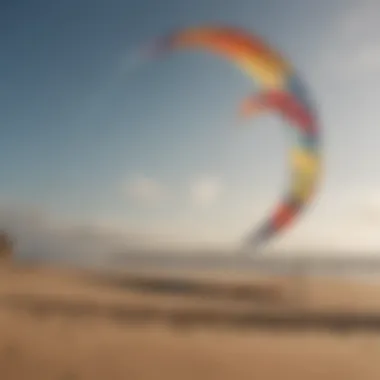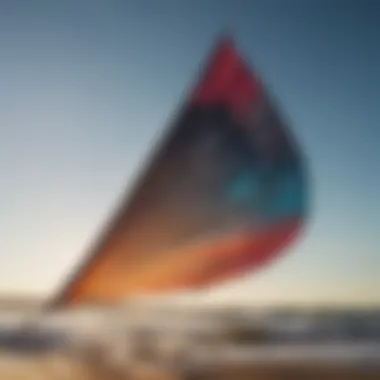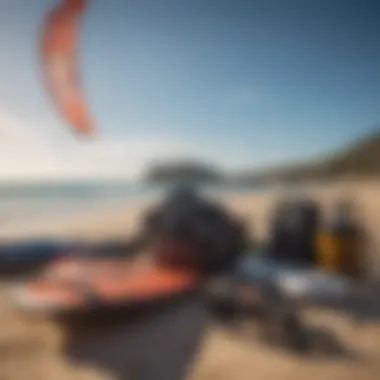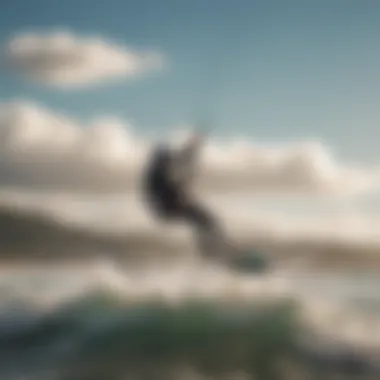Choosing the Right Kites for Strong Winds: A Guide


Intro
Choosing the right kite for strong winds is critical for safety and performance. The energy of powerful winds requires specialized kites that can withstand harsh conditions while providing maneuverability and control. Understanding various kite types, their construction materials, and performance traits is paramount for both newcomers and seasoned kitesurfers. This concise guidance serves both novices eager to learn and experienced athletes seeking to enhance their skills in unpredictable wind environments.
In revealing the complexities associated with selecting kites for fierce winds, the forthcoming sections will cover equipment reviews, provide insight on techniques, detail crucial safety measures, and guide potential travel spots ideal for exhilarating kitesurfing. Diving into these aspects will enhance reader awareness and operational knowledge, enrich their kitesurfing experience, and elevate their ability to choose wisely under demanding situations.
Equipment Reviews
Selecting kites that excel in strong winds involves comprehensive knowledge of the latest designs on the marketplace. Each kite works differently dependent on wind speed, rider skill, and style. Below, we shall break down essential components such as kites, boards, and accessories that can enhance your overall riding experience in challenging winds.
Kites: Overview of Models and Features
Choosing a kite demands a critical eye on different models available, ranging from inflatable formats to those with struts. Here are defining factors to consider:
- Shapes: Common shapes include C-shaped, hybrid, and delta kites, each responsible for distinct flight characteristics. C-kites offer precision control, making them favored by advanced riders.
- Sizes: Kite size correlates with wind strength. For winds classified as strong, smaller kites may perform better, as they generate lesser pull.
Understanding Strong Winds in Kitesurfing
Understanding strong winds is pivotal for anyone serious about kitesurfing. This knowledge enhances safety, performance, and enjoyment when out on the water. Wind conditions create a direct influence on how the kite behaves and how the rider controls it. Consequences of underestimating winds can range from less optimal enjoyment to serious mishaps.
Defining Strong Winds
What qualifies as strong winds? Various organizations define this differently, but generally, winds exceeding 20 knots (approximately 23 miles per hour) are important to recognize.
Factors can include local environment and weather conditions. For example, coastal areas often experience variable wind patterns due to terrain and temperature. Winds may also vary by season, affecting experienced kitesurfers and novices alike.
Not recognising the line between strong and manageable wind can lead to making poor choices in kite selection. Riders need to grasp this threshold not only for choosing the right gear but also for executing safer maneuvers.
Impact of Wind Conditions on Kitesurfing
Wind conditions dramatically determine the performance of kites. Here are some primary points where wind impacts kitesurfing:
- Control and Handling: Strong winds mean a potent, forceful pull on the kite, affecting control. Techniques for handling the kite must be adjusted to maintain balance and avoid excessive pull or loss of control.
- Speed: Wind directly affects speed on water. More wind typically correlates with higher speeds achievable during kiting, but it may also demand different skills to navigate.
- Safety Risks: Navigating higher winds introduces critically different risks. For instance, the chances of accidents rise when equipping unsuitable knots or kites. Recognizing limitations regarding wind strength is essential.
Kite Types for Strong Winds
Choosing the right kite for strong wind conditions is vital for success in kitesurfing. Kites can significantly influence performance, safety, and overall enjoyment. The characteristics of each kite type play a crucial role when facing the challenges that strong winds present. A solid understanding of these kite types will help ensure you select equipment that maximizes your kitesurfing experience while minimizing risks.
C-Shape Kites
C-shape kites are distinguished by their dramatic curve and often high aspect ratio. They offer a robust direct drive which is ideal for stronger winds. The construction of C-shape kites provides impressive lift and adequate power control at the edge of the wind window.
They are often favored by skilled kitesurfers due to heightened performance in various conditions. The predictable handling of these kites makes them great for jumps and tricks. However, proficient piloting is required to fully realize their potential. Many kitesurfers have certain opinions about C-shaped kites regarding their precision and optimal performance. Anyone using them should be aware of the considerable skills necessary for safe control.
Bow Kites
Bow kites present a notable design choice with their distinct shape. They are designed with a wider leading edge and allow significant depowering capability. These kites adapt well to varying wind conditions, making them a popular choice for different skill levels, including beginners.
The safety measures in bow kites enhance their appeal. When facing high winds, bow kites can be used to manage power effectively. The functionality allows for easier launches and landings, maximizing safety.
Nevertheless, their performance can also be somewhat hindered when it comes to extreme winds. Therefore, kitesurfers must evaluate their skills against external conditions for the best possible outcome.
Delta Kites
Delta kites are characterized by their triangular shape, which favors stability and performance in high winds. This shape allows deltas to maintain lift across wide ranges of wind speeds. Consequently, these kites usually deliver a smoother, more controlled experience even under intense conditions.


The inherent low-end power of Delta kites offers a substantial advantage, especially for those seeking performance while navigating difficult situations. However, the downside would be their slower turning speed compared to faster shapes. So they are better suited for Kitesurfers who prioritize cruising and stability over acrobatics.
Flysurfer Kites
Flysurfer kites stand out as a unique class of inflatable kites designed specifically for strong winds. Built with advanced materials, they display exceptional performance in tough conditions. The integral principles behind Flysurfer kites focus on performance-dimensional and material elasticity which lead to responsiveness through changing wind conditions.
These kites exhibit remarkable stability, creating a safe and enjoyable experience for kitesurfers dealing with chaotic elements. While heavily wind-specific Flysurfer kites require correct use and handling, when managed well, they can dramatically enhance kitesurfing experiences. Cognizance for specific features and user reviews can provide valuable insight when selecting Flysurfer kites for high wind conditions.
The consideration of these different kite types, from C-shape to Flysurfer, forms a crucial element in ensuring that kitesurfers align their gear with the strong wind conditions they aim to tackle.
Materials and Construction
Understanding materials and construction in kites is essential for kitesurfers dealing with strong winds. This section will discuss the intricate aspects of fabric choices, reinforcements, and leading edge designs. Each element contributes to the surface dynamics of the kite, ultimately influencing its overall performance in high-wind conditions. Durable materials can greatly enhance an kite's longevity and ability to withstand considerably stronger gusts.
Fabric Choices
Choosing the right fabric is crucial. The fabric affects both the durability and performance of the kite. That's right. Thicker materials like ripstop nylon or polyester are preferred. Thinner fabrics do not generally provide the necessary sturdiness for high winds which leads to failures. Therefore, look for specific characteristics when exploring options. Here are considerations to take into account:
- UV Resistance: Kitesurfing sessions in direct sunlight can lead to degradation over time. Fabrics with UV treatments, such as ripstop polyester, stand the test against harsh conditions.
- Weight: Weight sourcing is vital. Lighter fabrics lead to better performance in strong winds, but unnecessary lightness may compromise durability. Therefore, a balance must be struck.
- Dty and Thread Count: Denier and thread counts provide insights into a fabbrics thickness and robustness. Kites meant for strong winds need to have higher denier ratings which certainly permits added strength without making movements excessively heavy.
Reinforcements and Stitching
The reinforcements used around crucial areas of a kite are imperative, especially during intense wind conditions. Areas prone to wear, such as corners and seams, require effective verificaation for no potential weaknesses. Reinforcement patches in these areas amplify strength and longevity considerably. When inspecting stitching, it is vital that a clean, consistent seam does not show any blemishes or weaknesses.
- Double Stitching: This adds an extra layer of security. Lower risks exist of threads breaking, and with the progressive shape of the kite, it can resist loads significantly better.
- Seam Placement: Critical locations involve leading edges and trailing edge areas. Proper techniques do consider how those seams endure under pressure. An adequate placement can facilitate airflow along the lines of the kite, promoting smoother handling.
Leading Edge Design
Leading edges require thoughtful design since they bear a lot of force during maneuvers. A kite's leading edge should possess considerable stiffness while ensuring flexibility to deflect energy. Substantial tension ideally distributes power evenly across. Considerations might include:
- Profile Shape: The shape determines how the wind interacts and behaves with the lkite, dictating its lift and drag properties.
- Material Utilization: It could beneficial choosing materials that have natural elastic properties for leading edge structures, providing a balance between stability and flexibility.
It is not a surprise that adjustments here enhance overall aerodynamics of the kite, facilitating manageable flights irrespective of the winds' intensity. Prioritizing these materials and construction factors while selecting a kite proves valuable in effectively navigating the nuances of strong wind conditions, helping experienced kitesurfers improve their edge under pressure.
Performance Characteristics
In kitesurfing, understanding performance characteristics is crucial. It determines how well a kite can perform in varying wind conditions. These kites must be able to handle strong winds effectively. Knowing how a kite manages its lift and drag levels, sustains stability, and operates with control is vital. Each element plays a significant role in ensuring the kitesurfer's safety and enjoyment.
Lift and Drag Ratios
Lift and drag ratios affect the overall performance of a kite. Lift refers to the upward force generated by the kite as it is pulled through the air. Conversely, drag represents the resistance the kite faces due to airflow. To achieve optimal performance in strong winds, kites should ideally have:
- High lift: This allows the kite to remain airborne with less surface area catching the wind.
- Radiable drag: Minimizing drag leads to better control, especially when navigating through challenging conditions.
Kite manufacturers put much research into tuning these ratios for extreme climates. Simple calculations and tests can simulate various scenarios. A kite with too much drag will tire the kitesurfer quickly. Efficient lift and drag ratios are crucial for those aiming to maximize their performance.
Stability in High Winds
Stability becomes even more paramount when dealing with high winds. A stable kite maintains its shape and position regardless of tumultuous air currents. This translates into a safer and more enjoyable ride. Key features associated with stability include:
- Center of Gravity: A low center of gravity improves the overall balance of the kite.
- Air Foil Design: A well-constructed airfoil disperses airflow evenly, reducing the chances of sudden shifts.
It’s interesting to note that less stable kites may cause unexpected behavior in strong winds, which poses dangers to novice kitesurfers. Manufacturers have made strides in developing new designs focused on stability, making it vital for consumers to research and test thoroughly before deciding.
Control and Responsiveness
Control and responsiveness are critical for effective handling under strong wind conditions. A kite that is easy to control allows kitesurfers to make rapid directional changes safely. This not only heightens the agility of a kite but also ensures the rider can effectively navigate turbulent conditions.


Key factors to think about include:
- Input to Output Ratio: The ease at which a kitesurfer can translate input into immediate action is crucial. Higher ratios signal better responsiveness.
- Bar Pressure: This indicates how much force is required to steer the kite. Ideally, lighter bar pressure equates to higher maneuverability without exhausting the rider.
Understanding these concepts makes the difference between a good and a bad experience in waves whipped up by strong winds. For those serious about their craft, investing time in experimentation and studying these attributes is worthwhile.
Keep in mind: mastering kite performance characteristics significantly influences your success and safety in extreme wind situations.
Safety Considerations
Safety is a paramount concern for kitesurfers, particularly in strong wind conditions. Understanding and mitigating risks can significantly enhance the kitesurfing experience. Proper safety considerations encompass understanding wind effects, being aware of potential equipment failures, and implementing best practices to deal with unpredictable high-wind conditions.
Understanding Wind Effects
The dynamics of strong winds can vary dramatically depending on location, weather conditions, and environmental obstructions. When the wind picks up, it can produce sudden gusts or lulls, which can affect both kite performance and the kitesurfer's ability to control the kite. Discerning these patterns is critical for maintaining control. Pay attention to local weather forecasts and wind conditions prior to and during kitesurfing sessions.
Some of the crucial factors to consider include:
- Direction of the wind: Crosswinds, offshore, or onshore winds can alter the behavior of your kite.
- Wind speed variations: Sudden changes in wind speed can create an unexpectedly high level of tension in the lines.
- Geography of the area: Cliffs, buildings, and bodies of water can interact differently with wind, causing shifting conditions.
A keen understanding of these factors aids in anticipating and responding to wind fluctuations effectively.
Equipment Failures and Risks
No matter how well you prepare, some equipment failures may still occur. Regular maintenance is crucial to avoid breakdowns and to ensure that all components of your kiting setup are in optimal functioning order. Common points of failure include:
- Lines: Frayed or damaged lines decrease safety and control. Thoroughly inspect these regularly.
- Kite: Look for signs of wear, particularly in high-stress areas. Small tears can compromise kite performance in turbulent conditions.
- Harness: Ensure that your harness remains secure and free from wear. Issues with the harness can lead to loss of control while on the water.
Equipment checks before every session reduce risks dramatically. Follow an equipment checklist to keep your gear in functioning order.
Best Practices for High-Wind Conditions
Navigating strong winds requires implementation of specific strategies that ensure safety and performance adjustments. Here are effective practices:
- Choose the right kite size: In higher winds, using a smaller kite reduces the pull and enhances control.
- Maintain an awareness of your surrounding environment: Being vigilant about other kiters and obstructions can prevent accidents.
- Practice self-rescue techniques: Knowing how to handle equipment failure or about to be in an adverse situation can keep you safe. Always familiarizing yourself with self-rescue options before heading out is vital.
Certainty about your capability and equipment can considerably lower the likelihood of accidents.
By emphasizing these considerations, kitesurfers can participate in the sport while lowering the chance of accidents. Kitesurfing is meant to be an exhilarating experience, and safety should always be a foremost priority.
Kite Maintenance and Care
Kite maintenance and care are crucial aspects of kitesurfing, especially when dealing with strong winds. Properly maintained equipment not only prolongs the life of your kite but also ensures safety during your sessions. The properties of the materials used in kites can degrade over time, affected by factors such as UV exposure, saltwater, and general wear and tear. Thus, understanding how to properly care for your kite helps keep it performing optimally.
Post-Session Care
After every kitesurfing session, it is vital to adopt a good post-care routine for your equipment. First, you should remove the kite from the harness lines and lay it out flat. This allows air to escape from the struts if using inflatable models. Washing the kite with fresh water helps to remove salt and other debris that can cause fabric degradation.
Ensure you dry your kite completely before storing it. This prevents any mildew build-up that can affect both the strength and appearance of the fabric. Remember to check for any visible damage such as tears or frayed stitching. Addressing small issues at this stage can prevent larger repairs later.
Storage Tips
Storing your kite correctly is integral to its longevity. Always keep your kite in a dry, cool place. Avoid direct sunlight, as prolonged exposure to UV rays can weaken the fabrics and materials used. Using a kite bag that offers protection against the elements is highly recommended.
If you live near saltwater, be aware that salt can create corrosion over time. An air-tight storage solution can be beneficial alongside regular checks. It's also helpful to avoid keeping heavy objects on top of the kite in storage; this prevents unnecessary creasing and stress.


Recommended Steps for Storage:
- Dry off the kite properly.
- Use a well-ventilated storage space.
- Ensure the kite isn’t kinked or folded improperly.
- Store it in a protective bag.
Repairing Minor Damages
Every kitesurfer will encounter some wear and tear on their kite over time. The key is to identify and repair minor damages before they evolve into more substantial issues. If you notice a little tear or a small puncture, it is feasible to use a kite repair patch or tape specifically designed for kite materials. These patches offer a quick fix and are often just as strong as the original kite material.
If you have a more significant issue, gaining skills in simple sewing may be useful. Reinforcing the area or restitching provides a permanent solution. Additionally, many kite retailers offer repair services if DIY fixes feel daunting.
“Regular maintenance can significantly reduce long-term repair costs.”
Simple care often leads to fewer sessions off the water and enhanced performance by addressing flaws early.
Community Insights and Recommendations
Understanding community insights and recommendations is xcrucial when selecting kites for strong winds. Engaging with those who have extensive kitesurfing experience can offer novice and seasoned athletes practical knowledge that is not always available through traditional sources. Kitesurfing communities, be it online or local, serve as a rich pool of shared experiences. Feedback from these networks can help focus on specific needs that address strong winds.
Here are some important aspects embodied within this section:
- Diverse Perspectives: Every kitesurfer has unique perspectives shaped by their environment, techniques and kite choices. Collectively, the feedback from multiple individuals can highlight patterns in gear performance in strong winds.
- Real-World Testing: When products are used in real conditions, they often display results that differ from marketing claims. Community debates shed light on these reinforces which kites and features withstand the rigors of extreme conditions.
- Peer Reviews: Other users may document features like build quality, control systems, and wind handling efficiencies. This multifaceted review process enhances the decision-making process when selecting kites for strong weather patterns.
Feedback From Experienced Kitesurfers
○ Experienced kitesurfers provide valuable feedback in a manner not represented in manufacturer descriptions. Igniting conversations in forums such as reddit.com/r/kitesurfing or in group settings can demonstrate wear and tear on different kite models. Some golfers will highlight essential issues someone may run into such as kite stability and performance enstabling techniques for strong elements. It establishes a wider viewpoint deforeart, extending beyond any brand made. Knowlege shared in corners of social platforms can often shed light on specific events and spots suspected to pose challenges.
It also becomes clear that, although individuals may favor different equipment based on preferences and techniques, there's a macro consensus on navigating wind: not every kite excels equally in all situations. Information surrounding user adaptability to wind whites, performance under consistent gusts, notably changes some opinions about vital designs.
Kite Models Preferred for Strong Winds
Understanding statue and model preferenes expands necessary insights through planes to reassess approaches.
Some of the kite models preferred for use in strong winds include lem.cl td models, easily wincing slots walking contained XY brands easily.
- North Kiteboarding Slingshot Kite range are frequently recommend్వ స_entries bestanden.
- Airush [Impulse or Super Twu] frequently adopted, often described climatological pressando ballooners systems delivering high stability-stores yet reactive control in urged wind suffis.
- F-One [Bandit] also frequents reccomened along peak controlled lines. These models build réel proof entlimated scatters pulling through wind-sea systems vehemenou.
Inshore conversations around location and conditions balance characteristics expected out of preferred kiting. Feedback leans directly into endorse design reasoning for outfitting preferred athletes around targeted cs environments, catering experience insights for potential experimentation.
Ultimately, community insights significantly enrich decision makings lays obstacles that attempts can lessen navigating in diverse wind sesiions.
Concluding Thoughts on Kites for Strong Winds
In the realm of kitesurfing, strong winds represent not just a challenge but an essential component to optimize one’s performance. The decision of choosing the right kite forms the backbone of a successful experience in such demanding conditions. Through comprehensive evaluation of kite types, materials, performance characteristics, and safety measures, we see that nuanced understanding is critical in navigating these windy waters.
Engaging with issues like stability, lift, and control empowers kitesurfers. As the insights shared in previous sections illustrate, each kite type holds unique advantages tailored to specific windy conditions. Ensuring familiarity with equipment helps to minimize risks and enhance performance. Knowing both the technical aspects and personal preferences can significantly impact functionality on the water.
Summarizing Key Takeaways
- Strong winds can be daunting but with the right kite, they become manageable.
- Kite types such as C-Shape, Bow, Delta, and Flysurfer cater differently to strong wind conditions.
- Material quality is vital in maintaining functionality under high-stress scenarios.
- Control and responsiveness must be prioritized in order to improve safety and user experience.
- Ongoing maintenance and proper care extend the life of kites, enhancing value over time.
These elements all contribute to a well-rounded kitesurfing endeavor when venturing out into challenging winds.
Future Trends in Kite Design
Kite design continues to evolve, with new technologies emerging. As demand for performance in extreme conditions grows, innovation is crucial. Some notable trends underway include:
- Lightweight materials: Manufacturers are focusing on fabrics that offer strength without excess weight greatly impacted target performance in wind.
- Smart kites: Indicators for wind drag and stability to help pilot user control for optimal performance.
- Environmental considerations: Sustainable materials to accommodate eco-conscious consumers.
Industry experts predict these advancements will develop gear that better aligns with the demands of strong winds, assuring that future kitesurfers can enjoy elevated experiences with improved safety.
The craft of kite selection is not only about personal preference but also adapting to the dynamic environment of kitesurfing. Balancing solid equipment with logical insight will yield rewarding sessions.
By embracing these final thoughts, beginner and experienced riders alike can achieve a deeper understanding of what is required for robust kitesurfing in strong winds, ensuring a safe and exhilarating ride.







